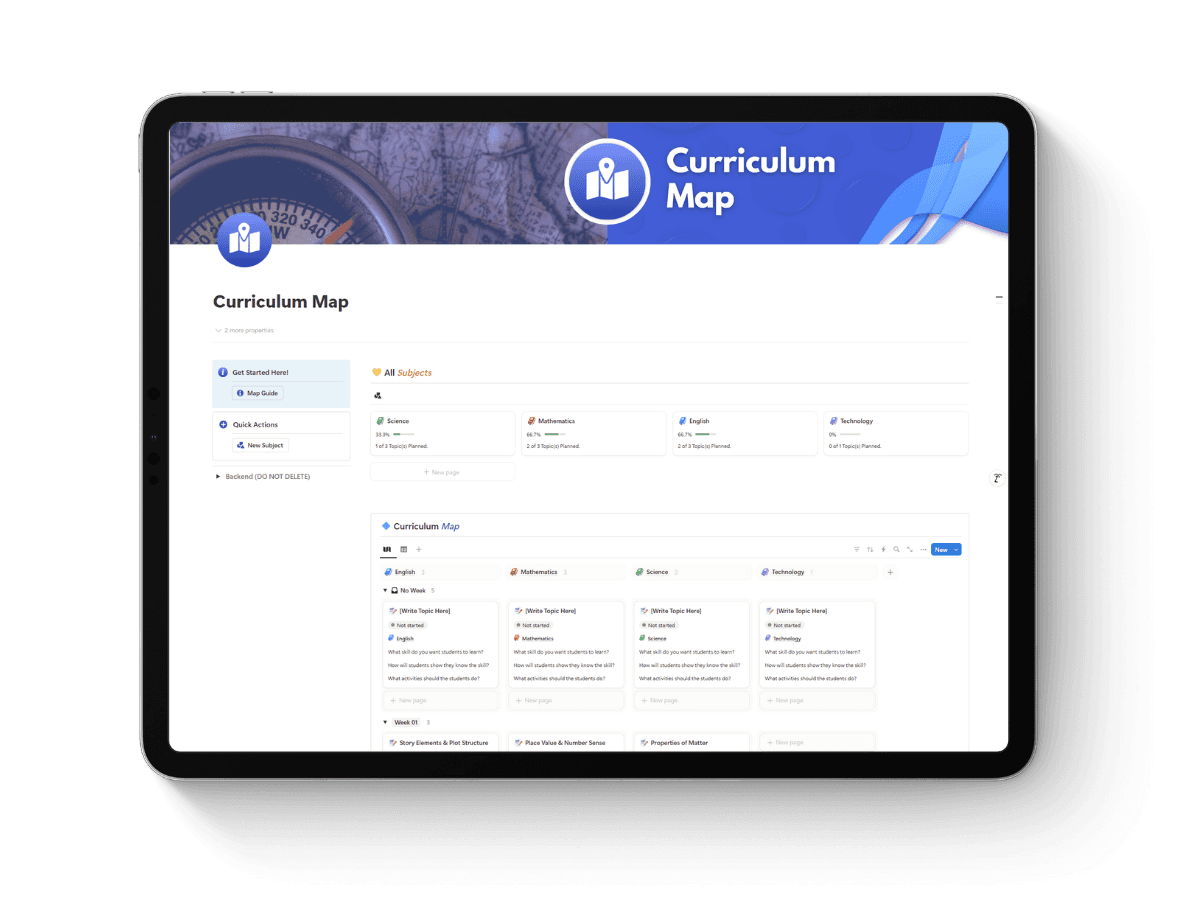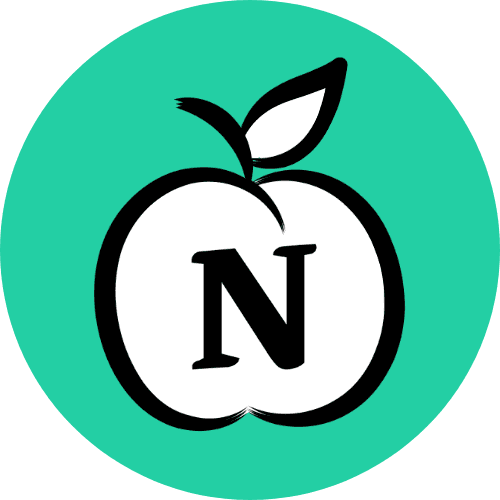Curriculum Map Template
Effortlessly create your weekly curriculum with an easy-to-use builder. Get your free copy now!



Align Standards with a Curriculum Tool Built in Notion
Align Standards with a Curriculum Tool Built in Notion
Align Standards with a Curriculum Tool Built in Notion

Article by
Milo
ESL Content Coordinator & Educator
ESL Content Coordinator & Educator
All Posts
Curriculum Map Template
Effortlessly create your weekly curriculum with an easy-to-use builder. Get your free copy now!

Curriculum Map Template
Effortlessly create your weekly curriculum with an easy-to-use builder. Get your free copy now!

Curriculum Map Template
Effortlessly create your weekly curriculum with an easy-to-use builder. Get your free copy now!

The Challenges of Aligning Standards with Curriculum
Ever find yourself staring at a list of academic standards, wondering how on earth they connect to your actual lesson plans? You’re not alone. Aligning educational standards with daily curriculum can feel like trying to glue two puzzle pieces together that weren’t meant to fit, without the box for reference.
Let’s dig into why this process is tricky, what makes it so frustrating, and why most teachers wish it came with a manual (or a magic wand).
The Jargon Jungle: Lost in Translation
Educational standards often sound like they were written in another language... possibly by a committee of cryptic philosophers.
“Students will demonstrate command of the conventions of standard English grammar and usage...”
Okay, but does that mean a lesson on commas or an essay on The Great Gatsby?
This vague, jargon-filled language leaves a lot of room for interpretation. Teachers must act as translators, figuring out what each standard really means in terms of practical classroom activities. It’s no wonder the process can feel overwhelming.
One Standard, Many Interpretations
Even when the language makes sense, standards are rarely one-size-fits-all. One school district might interpret a math standard to mean “teach long division,” while another insists it means “focus on problem-solving.”
This lack of consistency creates big challenges for:
Teachers trying to collaborate across schools
Curriculum planners building lesson structures
Parents understanding what their kids are learning
Adding to the chaos? Standards frequently change. Just when you think you’ve mastered them—bam! New version. Rewrite required.
The Time-Drain Dilemma
Time. The one thing teachers never have enough of.
Aligning lesson plans to standards takes hours of behind-the-scenes work:
Reading and interpreting each standard
Matching it to existing lessons
Finding gaps or overlaps
Revising lesson materials accordingly
That’s time away from crafting engaging activities or giving feedback on student work. It’s like doing homework for your homework.
Navigating standards and aligning them with curriculum isn’t impossible, but it does have its pitfalls. The good news? Tools and techniques are emerging to make the path smoother. In the next section, let’s explore why getting this alignment right matters so much—and how it can actually make teaching more dynamic and focused. Stay with me.

The Importance of Aligning Standards for Effective Teaching
Ever get the feeling that your lesson plans are solid, your students are engaged, but somehow you're not quite hitting the mark? That “off” feeling could come down to one key issue: misalignment with standards.
Standards aren’t just hoops to jump through—they’re the roadmap. When your curriculum and assessments line up with them, teaching becomes more focused, students succeed faster, and everyone breathes easier (yes, even during testing season).
Let’s break down why aligning with standards isn’t just a bureaucratic checkbox—it’s your secret weapon.
Why Standards Matter (Even If They Feel Overwhelming)
Education standards—like Common Core, NGSS, or state-specific ones—are designed to ensure consistency in what students learn, no matter where they live. That’s important. It helps:
Keep learning goals clear and measurable
Support student progress grade-by-grade
Make sure no essential skills fall through the cracks
When teachers align their instruction to those standards, it creates a learning experience that’s coherent, intentional, and impactful.
Imagine trying to bake a cake without a recipe. You might end up with a delicious disaster—or just a disaster. Standards are the recipe. They guide you on what ingredients (skills and knowledge) to use and in what order.
Better Planning, Better Results
Aligning to standards makes planning easier and smarter.
When you know exactly what your students need to master, it becomes clearer how to:
Choose the right content and materials
Design effective lessons and units
Build assessments that actually measure what matters
Instead of guessing what to teach next, you have a roadmap. Teaching becomes more efficient, and your lessons carry more purpose.
For example, if you're teaching a 5th grade writing unit, aligning it with the writing standards means you’re not just telling kids to “write better.” You’re helping them master specific skills like developing arguments or using evidence—skills they’ll need on tests and in real life.
Teaching with Confidence (and Less Stress)
Let’s be real: Teaching is hard enough without guessing whether your lessons meet expectations.
When your lessons align with standards, it builds confidence. You know your students are learning what they’re supposed to, and admin walkthroughs or parent questions don’t phase you.
Bonus? Come testing season, both you and your students are prepared. No more last-minute cram sessions to “cover” forgotten standards.
How Notion Simplifies Curriculum Mapping
Ever tried juggling lesson plans, standards, assessments, and scope and sequence charts across four different Google Docs, two spreadsheets, and a crumpled sticky note? If so, you’re not alone—and Notion might just become your new teaching best friend.
Curriculum mapping can feel overwhelming. It’s like trying to piece together a 1,000-piece puzzle without having the picture on the box. But here's the good news: Notion simplifies the entire process into one organized, easy-to-navigate workspace.
Let’s unpack how.
Want to skip ahead? You can download the free template here.

Everything in One Place. Finally.
Notion acts as your digital curriculum binder (minus the guilt of not labeling your tabs). You can combine:
Learning standards
Lesson plans
Unit outlines
Assessments
Resources and media
Because it’s customizable, you’re not stuck with someone else's template or system. Want to link a standard directly to a lesson? Do it. Prefer tagging each unit by skill or theme? Go for it.
Example: Ms. Johnson, a high school biology teacher, linked every NGSS (Next Generation Science Standards) standard to her lab activities. When planning, she could instantly answer admin questions like, “Which standards are covered this quarter?” All without touching a spreadsheet.
Visual Clarity for Complex Curricula
Notion lets you view your curriculum in the way that works best for you:
Use database views like calendar, table, Kanban board, or gallery
Filter by grade level, subject, term, or standard
Add progress checkboxes to track completion
This makes it super easy to spot gaps or overlaps in your instruction. Example: In a visual board view, an elementary teacher could see that she’d heavily covered reading comprehension but hadn’t touched on vocabulary development yet.
No Learning Curve? Almost.
Is Notion techy? A little. But it's surprisingly user-friendly, especially with pre-built templates. You don’t need to be a tech wizard—just comfortable clicking around and dragging blocks.
Think of it like organizing a digital notebook—except this one won’t get coffee stains or magically disappear from your desk. Bonus: you can access it from your phone, tablet, or laptop anytime.
Once you’ve seen how Notion brings order to curriculum chaos, you might start wondering how you lived without it. Ready to get your own workspace set up? Let’s keep going and walk through the steps to build your curriculum tool in Notion.
Steps to Set Up Your Curriculum Tool in Notion
Ever found yourself drowning in binders, lesson plans, and half-scribbled post-it notes? You're not alone. Mapping curriculum and keeping it aligned with standards used to mean cluttered desks and hefty Excel sheets. But what if you could organize it all—standards, units, pacing, assessments—in one sleek digital space? Enter Notion.
Setting up your own curriculum tool in Notion may sound intimidating, but trust me—it's much easier than deciphering your 8 a.m. coffee order on a Monday. Let’s walk through it in manageable steps.
Want to skip ahead? You can download the free template here.
1. Create a New Notion Workspace or Page
First things first—open Notion.
If you’re new to Notion, sign up and start a new workspace just for your curriculum planning.
Already using Notion? Great! Create a new page within your current setup and title it something like “Curriculum Hub” or “Lesson Masterplan” (bonus points for teacher creativity).
Give it a fun emoji icon. Maybe a book, a chalkboard, or even a coffee cup—something that makes you smile.

2. Add a Database to Track Your Units
This is where the Notion magic really kicks in.
Click “+ Add a Database” and choose “Table – Full Page”.
Name this table “Units” or “Curriculum Map”.
Next, make it work for you:
Add columns like:
Grade Level (if you teach multiple)
Unit Title
Learning Objectives
Standards Aligned
Essential Questions
Assessment Methods
Resources/Materials
Now you’ve got a living document that stores everything in one spot. And it’s searchable. Instant upgrade from that old binder.

3. Link Standards to Each Unit
This is where alignment gets real (and real easy).
Create a second database titled “Standards.”
Include:
Standard Code
Grade
Domain or Strand
Description
Once this is set, link your “Units” database to “Standards” using a relation field. That way, when you're building or editing a unit, you can directly connect it to one or more standards from your list. No more bouncing between documents and hoping things line up.
Ready to skip the setup and dive straight in? We've got something special coming next: a free Notion template to get you started in seconds. You're just one click away. 👇

Download Your Free Notion Curriculum Template
Ever spend hours building a lesson plan tracker just to end up abandoning it halfway? You’re not alone. A lot of teachers start with good intentions—sticky notes, spreadsheets, maybe even a fancy binder—but keeping everything updated and streamlined? That's a whole different story.
How to Get It (For Free!)
We’ve made it super easy to grab your free copy:
Click the Download Link 👉 Free Curriculum Map Template Download
Duplicate it into your own Notion workspace (you’ll need a free Notion account).
Customize it for your subjects, grade levels, and teaching style.
Start mapping, scheduling, and most importantly—teaching with less stress.
(Pro tip: Once it’s yours, you can tweak it however you'd like. Add pages, insert images, even link external resources. It’s your creative playground.)
What’s Included in the Template?
Let’s take a peek inside the template. You’ll find a clean, flexible setup that includes:
Curriculum Map Dashboard – Your bird’s eye view of the whole year.
Standards Library – A place to store all your state or national standards for quick access.
Unit + Lesson Planner – Plan your units by goals, then break them down into daily lessons.
Pacing Calendar – Visualize your teaching schedule over weeks or months.
Tagging and Filtering Options – Sort lessons by unit, grade, subject, and more.
It's organized, intuitive, and—most importantly—actually fun to use. One teacher called it the “Marie Kondo of curriculum planning” (which we still think about daily).
Who’s This Template For?
This template is perfect for:
K-12 teachers juggling multiple subjects and classes.
Instructional Coaches helping others build pacing guides.
School Leaders who want alignment without micromanaging.
Homeschool Educators looking for better structure with flexibility.
Basically, if you teach, plan, or support instruction, this tool will save you time and sanity.
Download the template, take it for a spin, and see how much smoother curriculum planning can be. Up next, we’ll walk you through setting it up so it fits like your favorite hoodie—custom, comfy, and ready to work.
The Challenges of Aligning Standards with Curriculum
Ever find yourself staring at a list of academic standards, wondering how on earth they connect to your actual lesson plans? You’re not alone. Aligning educational standards with daily curriculum can feel like trying to glue two puzzle pieces together that weren’t meant to fit, without the box for reference.
Let’s dig into why this process is tricky, what makes it so frustrating, and why most teachers wish it came with a manual (or a magic wand).
The Jargon Jungle: Lost in Translation
Educational standards often sound like they were written in another language... possibly by a committee of cryptic philosophers.
“Students will demonstrate command of the conventions of standard English grammar and usage...”
Okay, but does that mean a lesson on commas or an essay on The Great Gatsby?
This vague, jargon-filled language leaves a lot of room for interpretation. Teachers must act as translators, figuring out what each standard really means in terms of practical classroom activities. It’s no wonder the process can feel overwhelming.
One Standard, Many Interpretations
Even when the language makes sense, standards are rarely one-size-fits-all. One school district might interpret a math standard to mean “teach long division,” while another insists it means “focus on problem-solving.”
This lack of consistency creates big challenges for:
Teachers trying to collaborate across schools
Curriculum planners building lesson structures
Parents understanding what their kids are learning
Adding to the chaos? Standards frequently change. Just when you think you’ve mastered them—bam! New version. Rewrite required.
The Time-Drain Dilemma
Time. The one thing teachers never have enough of.
Aligning lesson plans to standards takes hours of behind-the-scenes work:
Reading and interpreting each standard
Matching it to existing lessons
Finding gaps or overlaps
Revising lesson materials accordingly
That’s time away from crafting engaging activities or giving feedback on student work. It’s like doing homework for your homework.
Navigating standards and aligning them with curriculum isn’t impossible, but it does have its pitfalls. The good news? Tools and techniques are emerging to make the path smoother. In the next section, let’s explore why getting this alignment right matters so much—and how it can actually make teaching more dynamic and focused. Stay with me.

The Importance of Aligning Standards for Effective Teaching
Ever get the feeling that your lesson plans are solid, your students are engaged, but somehow you're not quite hitting the mark? That “off” feeling could come down to one key issue: misalignment with standards.
Standards aren’t just hoops to jump through—they’re the roadmap. When your curriculum and assessments line up with them, teaching becomes more focused, students succeed faster, and everyone breathes easier (yes, even during testing season).
Let’s break down why aligning with standards isn’t just a bureaucratic checkbox—it’s your secret weapon.
Why Standards Matter (Even If They Feel Overwhelming)
Education standards—like Common Core, NGSS, or state-specific ones—are designed to ensure consistency in what students learn, no matter where they live. That’s important. It helps:
Keep learning goals clear and measurable
Support student progress grade-by-grade
Make sure no essential skills fall through the cracks
When teachers align their instruction to those standards, it creates a learning experience that’s coherent, intentional, and impactful.
Imagine trying to bake a cake without a recipe. You might end up with a delicious disaster—or just a disaster. Standards are the recipe. They guide you on what ingredients (skills and knowledge) to use and in what order.
Better Planning, Better Results
Aligning to standards makes planning easier and smarter.
When you know exactly what your students need to master, it becomes clearer how to:
Choose the right content and materials
Design effective lessons and units
Build assessments that actually measure what matters
Instead of guessing what to teach next, you have a roadmap. Teaching becomes more efficient, and your lessons carry more purpose.
For example, if you're teaching a 5th grade writing unit, aligning it with the writing standards means you’re not just telling kids to “write better.” You’re helping them master specific skills like developing arguments or using evidence—skills they’ll need on tests and in real life.
Teaching with Confidence (and Less Stress)
Let’s be real: Teaching is hard enough without guessing whether your lessons meet expectations.
When your lessons align with standards, it builds confidence. You know your students are learning what they’re supposed to, and admin walkthroughs or parent questions don’t phase you.
Bonus? Come testing season, both you and your students are prepared. No more last-minute cram sessions to “cover” forgotten standards.
How Notion Simplifies Curriculum Mapping
Ever tried juggling lesson plans, standards, assessments, and scope and sequence charts across four different Google Docs, two spreadsheets, and a crumpled sticky note? If so, you’re not alone—and Notion might just become your new teaching best friend.
Curriculum mapping can feel overwhelming. It’s like trying to piece together a 1,000-piece puzzle without having the picture on the box. But here's the good news: Notion simplifies the entire process into one organized, easy-to-navigate workspace.
Let’s unpack how.
Want to skip ahead? You can download the free template here.

Everything in One Place. Finally.
Notion acts as your digital curriculum binder (minus the guilt of not labeling your tabs). You can combine:
Learning standards
Lesson plans
Unit outlines
Assessments
Resources and media
Because it’s customizable, you’re not stuck with someone else's template or system. Want to link a standard directly to a lesson? Do it. Prefer tagging each unit by skill or theme? Go for it.
Example: Ms. Johnson, a high school biology teacher, linked every NGSS (Next Generation Science Standards) standard to her lab activities. When planning, she could instantly answer admin questions like, “Which standards are covered this quarter?” All without touching a spreadsheet.
Visual Clarity for Complex Curricula
Notion lets you view your curriculum in the way that works best for you:
Use database views like calendar, table, Kanban board, or gallery
Filter by grade level, subject, term, or standard
Add progress checkboxes to track completion
This makes it super easy to spot gaps or overlaps in your instruction. Example: In a visual board view, an elementary teacher could see that she’d heavily covered reading comprehension but hadn’t touched on vocabulary development yet.
No Learning Curve? Almost.
Is Notion techy? A little. But it's surprisingly user-friendly, especially with pre-built templates. You don’t need to be a tech wizard—just comfortable clicking around and dragging blocks.
Think of it like organizing a digital notebook—except this one won’t get coffee stains or magically disappear from your desk. Bonus: you can access it from your phone, tablet, or laptop anytime.
Once you’ve seen how Notion brings order to curriculum chaos, you might start wondering how you lived without it. Ready to get your own workspace set up? Let’s keep going and walk through the steps to build your curriculum tool in Notion.
Steps to Set Up Your Curriculum Tool in Notion
Ever found yourself drowning in binders, lesson plans, and half-scribbled post-it notes? You're not alone. Mapping curriculum and keeping it aligned with standards used to mean cluttered desks and hefty Excel sheets. But what if you could organize it all—standards, units, pacing, assessments—in one sleek digital space? Enter Notion.
Setting up your own curriculum tool in Notion may sound intimidating, but trust me—it's much easier than deciphering your 8 a.m. coffee order on a Monday. Let’s walk through it in manageable steps.
Want to skip ahead? You can download the free template here.
1. Create a New Notion Workspace or Page
First things first—open Notion.
If you’re new to Notion, sign up and start a new workspace just for your curriculum planning.
Already using Notion? Great! Create a new page within your current setup and title it something like “Curriculum Hub” or “Lesson Masterplan” (bonus points for teacher creativity).
Give it a fun emoji icon. Maybe a book, a chalkboard, or even a coffee cup—something that makes you smile.

2. Add a Database to Track Your Units
This is where the Notion magic really kicks in.
Click “+ Add a Database” and choose “Table – Full Page”.
Name this table “Units” or “Curriculum Map”.
Next, make it work for you:
Add columns like:
Grade Level (if you teach multiple)
Unit Title
Learning Objectives
Standards Aligned
Essential Questions
Assessment Methods
Resources/Materials
Now you’ve got a living document that stores everything in one spot. And it’s searchable. Instant upgrade from that old binder.

3. Link Standards to Each Unit
This is where alignment gets real (and real easy).
Create a second database titled “Standards.”
Include:
Standard Code
Grade
Domain or Strand
Description
Once this is set, link your “Units” database to “Standards” using a relation field. That way, when you're building or editing a unit, you can directly connect it to one or more standards from your list. No more bouncing between documents and hoping things line up.
Ready to skip the setup and dive straight in? We've got something special coming next: a free Notion template to get you started in seconds. You're just one click away. 👇

Download Your Free Notion Curriculum Template
Ever spend hours building a lesson plan tracker just to end up abandoning it halfway? You’re not alone. A lot of teachers start with good intentions—sticky notes, spreadsheets, maybe even a fancy binder—but keeping everything updated and streamlined? That's a whole different story.
How to Get It (For Free!)
We’ve made it super easy to grab your free copy:
Click the Download Link 👉 Free Curriculum Map Template Download
Duplicate it into your own Notion workspace (you’ll need a free Notion account).
Customize it for your subjects, grade levels, and teaching style.
Start mapping, scheduling, and most importantly—teaching with less stress.
(Pro tip: Once it’s yours, you can tweak it however you'd like. Add pages, insert images, even link external resources. It’s your creative playground.)
What’s Included in the Template?
Let’s take a peek inside the template. You’ll find a clean, flexible setup that includes:
Curriculum Map Dashboard – Your bird’s eye view of the whole year.
Standards Library – A place to store all your state or national standards for quick access.
Unit + Lesson Planner – Plan your units by goals, then break them down into daily lessons.
Pacing Calendar – Visualize your teaching schedule over weeks or months.
Tagging and Filtering Options – Sort lessons by unit, grade, subject, and more.
It's organized, intuitive, and—most importantly—actually fun to use. One teacher called it the “Marie Kondo of curriculum planning” (which we still think about daily).
Who’s This Template For?
This template is perfect for:
K-12 teachers juggling multiple subjects and classes.
Instructional Coaches helping others build pacing guides.
School Leaders who want alignment without micromanaging.
Homeschool Educators looking for better structure with flexibility.
Basically, if you teach, plan, or support instruction, this tool will save you time and sanity.
Download the template, take it for a spin, and see how much smoother curriculum planning can be. Up next, we’ll walk you through setting it up so it fits like your favorite hoodie—custom, comfy, and ready to work.
Curriculum Map Template
Effortlessly create your weekly curriculum with an easy-to-use builder. Get your free copy now!

Curriculum Map Template
Effortlessly create your weekly curriculum with an easy-to-use builder. Get your free copy now!

Curriculum Map Template
Effortlessly create your weekly curriculum with an easy-to-use builder. Get your free copy now!

Table of Contents
Curriculum Map Template
Effortlessly create your weekly curriculum with an easy-to-use builder. Get your free copy now!
2025 Notion4Teachers. All Rights Reserved.
2025 Notion4Teachers. All Rights Reserved.
2025 Notion4Teachers. All Rights Reserved.
2025 Notion4Teachers. All Rights Reserved.







